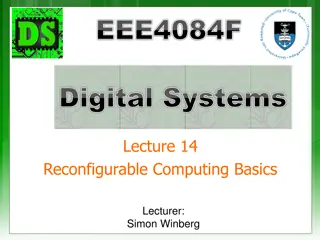Modelling and Exploration of Coarse-Grained Reconfigurable Arrays Using CGRA-ME Framework
This content discusses the CGRA-ME framework for modelling and exploration of Coarse-Grained Reconfigurable Arrays (CGRA). It covers the objectives, architecture description, inputs required, and tools included in the framework. CGRA-ME allows architects to model different CGRA architectures, map ap
2 views • 33 slides
AI-Based On-Board Reconfigurable FDIR and Lifetime Prediction for Constellations
This presentation discusses implementing AI-based enhanced FDIR and prognostics on-board solutions for constellations to improve fault detection, root cause analysis, and failure prediction, aiming to enhance service availability and reduce operational costs.
1 views • 19 slides
Rate Optimization in Wideband RIS-assisted Wireless Systems
This research focuses on rate optimization in wideband RIS-assisted wireless systems, specifically investigating MIMO RIS-assisted systems in sub-6 GHz mmWave settings. Pathloss and blockage modeling, along with LOS vs. spectral efficiency and RIS-UE distance vs. spectral efficiency analyses, are ke
0 views • 4 slides
Understanding Programmable Logic Devices (PLD) in Digital Electronics
Programmable Logic Devices (PLDs) are versatile electronic components used to create reconfigurable digital circuits, distinct from fixed-function integrated circuits. PLDs require programming before use, enabling customization for specific functions. This article explores PLDs, digital electronic s
0 views • 10 slides
Development of Reconfigurable Low Cost Multi-Mode Radar System for Vital Signs Detection
This project focuses on creating a reconfigurable radar system for contactless vital signs monitoring. By utilizing a hybrid approach of UWB and CW modes, the system aims to achieve high sensitivity and resolution with minimal size, weight, and power consumption. The innovative design allows for mul
0 views • 4 slides
Enhancing Throughput in Multi-Hop Wireless Networks Using Reconfigurable Antennas
In this study presented at IEEE SECON 2018, the authors investigate the throughput limits of multi-hop wireless networks employing reconfigurable antennas (RAs). Challenges such as unreliable links, interference, and large overhead are addressed, with existing approaches at both the link/network lay
0 views • 29 slides
Insights on CSE Department Developments by Jason D. Bakos
Jason D. Bakos has been actively involved in the Computer Engineering program, focusing on computer architecture for high-performance and embedded computing. His recent recognition includes chairing a top US reconfigurable computing conference steering committee. The CSE faculty changes, challenges,
0 views • 35 slides
Reconfigurable In-Rack Network for Rack-Scale Computers
Designing a reconfigurable in-rack network to enhance performance and reduce costs in rack-scale computers. The XFabric project focuses on adapting network topology to traffic flow, resulting in lower path lengths and reduced oversubscription. By implementing circuit-switched fabric with electrical
0 views • 21 slides
Overview of Phaethon: LightPath Provisioning Adapter for LightSoft
Phaethon is a lightpath provisioning adapter designed for LightSoft, providing capabilities such as reconfigurable optical add-drop multiplexing and transponder filtering. It integrates with the GRNET OSS/BSS stack and facilitates operations like transforming CORBA calls to HTTP REST calls and manag
0 views • 25 slides
Building Dashboards with JMP 13: Organizing and Reproducing Reports Dynamically
JMP 13 introduces new features for creating interactive dashboards with multiple reports using Docking Panels for reconfigurable layouts. Dashboards can be customized using Combine Windows, Dashboard Builder, or JSL, allowing for dynamic organization and visualization of data. Learn how to maximize
1 views • 9 slides
Reconfigurable Computing Basics and Trends Overview
Reconfigurable Computing (RC) is gaining popularity as software processors face limitations in speed and parallelism. FPGAs offer a solution by implementing complex functions and enabling spatial computation. The course covers RC basics, Verilog introduction, and dual processing techniques for verif
0 views • 16 slides
Reconfigurable FTL Architecture for NAND Flash-Based Applications
NAND Flash memory is commonly used in mobile devices due to its reliability and non-volatile nature. Flash Translation Layer (FTL) plays a crucial role in optimizing NAND flash performance and lifetime. The design of FTL should focus on hiding technological details, maximizing performance, and consi
0 views • 17 slides











